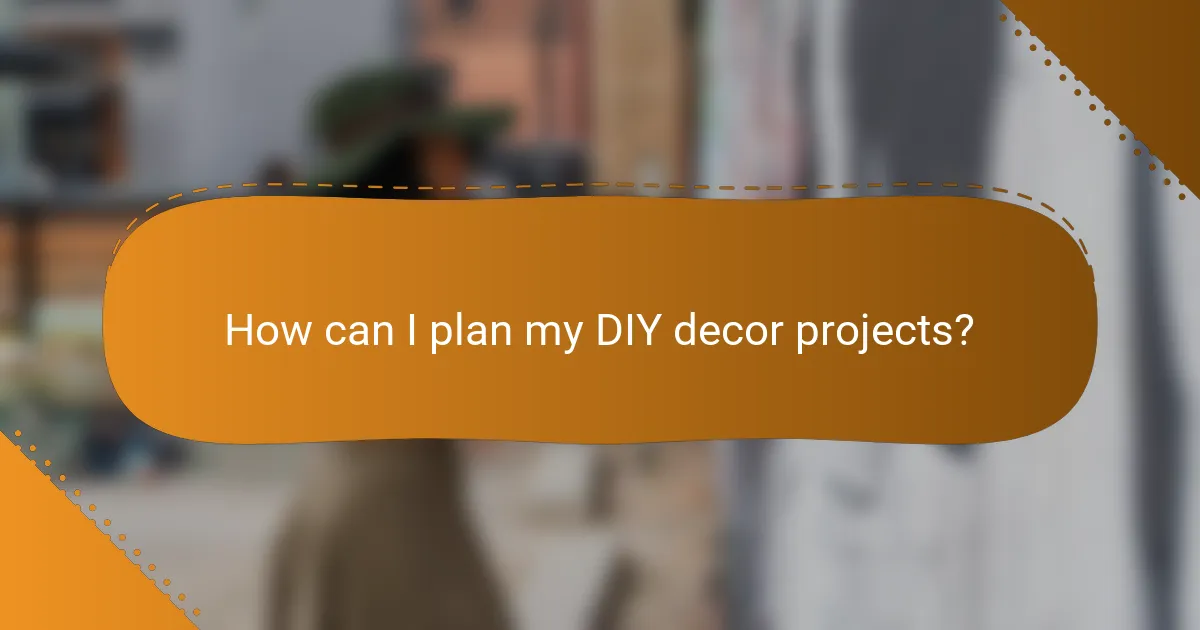Transforming your home with stunning DIY decor on a $100 budget is not only possible but also a rewarding creative endeavor. By utilizing thrift store treasures, repurposing furniture, and sourcing affordable materials, you can elevate your space without overspending. Dive into projects like wall art and upcycled furniture to personalize your home while keeping costs low.

How can I create stunning DIY home decor on a $100 budget?
Creating stunning DIY home decor on a $100 budget is entirely feasible with some creativity and resourcefulness. By leveraging thrift store finds, repurposing existing furniture, and incorporating budget-friendly materials, you can transform your space without overspending.
Use thrift store finds
Thrift stores are treasure troves for unique home decor items at low prices. Look for vintage furniture, decorative pieces, or even art that can be easily refreshed with a coat of paint or new hardware. You can often find items priced between $5 and $30, allowing you to mix and match for a personalized look.
When shopping, keep an open mind and consider how items can be transformed. A simple frame can become a gallery wall centerpiece, while an old lamp can be updated with a new shade. Always check for quality and structural integrity to ensure your finds are worth the investment.
Repurpose existing furniture
Repurposing existing furniture is a cost-effective way to refresh your home decor. Instead of buying new pieces, consider what you already own that can be updated or reimagined. For instance, an old dresser can be painted and used as a TV stand, or a bookshelf can be turned into a stylish bar cart.
To effectively repurpose, assess the functionality and aesthetics of your current furniture. Simple changes like adding new knobs, changing the color, or rearranging pieces can create a completely new look without the expense of new purchases.
Incorporate budget-friendly materials
Using budget-friendly materials is essential for sticking to your $100 limit. Materials like plywood, fabric remnants, and even recycled items can be transformed into beautiful decor. For example, you can create custom shelves from plywood or make throw pillows from inexpensive fabric.
Consider DIY projects that utilize these materials, such as creating wall art from reclaimed wood or building simple furniture pieces. Always look for sales or discounts at local craft stores to maximize your budget and explore online tutorials for inspiration and guidance.

What are the best DIY decor projects under $100?
Some of the best DIY decor projects under $100 include wall art, upcycled furniture, and decorative pillows. These projects not only enhance your space but also allow for creativity and personalization without breaking the bank.
Wall art using canvas and paint
Creating wall art with canvas and paint is a straightforward and cost-effective way to add personality to your home. You can purchase blank canvases for around $10 each and use acrylic paints to design unique pieces that reflect your style.
Consider using techniques like abstract painting, stenciling, or even pouring paint for interesting effects. A simple color palette can unify your decor, and you can easily create multiple pieces to form a gallery wall.
Upcycled furniture makeovers
Upcycling furniture involves transforming old or thrifted pieces into stylish new items. Look for wooden chairs, tables, or dressers that can be refreshed with paint, new hardware, or upholstery, often for under $100 total.
Before starting, assess the condition of the piece and choose a design that complements your existing decor. Simple updates like sanding and repainting can yield dramatic results, making your furniture both functional and aesthetically pleasing.
DIY decorative pillows
Making decorative pillows is an affordable way to refresh your living space. You can find pillow forms for around $5 to $15 and use fabric remnants or inexpensive materials to create custom covers.
Consider using techniques like sewing, no-sew methods with fabric glue, or even tie-dye for a fun twist. Adding embellishments like buttons or tassels can elevate the look without significant expense, allowing you to change the feel of a room easily.

Where can I find affordable decor supplies?
Affordable decor supplies can be found in various places, including local craft stores, online marketplaces, and home improvement retailers. Each option offers unique benefits that can help you stay within a $100 budget while creating stunning DIY home decor.
Local craft stores
Local craft stores are often treasure troves for budget-friendly decor supplies. Stores like Michaels or Joann Fabrics frequently have sales and discounts on materials such as paint, fabric, and decorative items.
When shopping at these stores, consider using coupons or loyalty programs to maximize savings. Look for clearance sections where you can find high-quality items at reduced prices.
Online marketplaces like Etsy
Online marketplaces, particularly Etsy, offer a wide range of handmade and vintage decor items at various price points. You can find unique pieces that add character to your home without breaking the bank.
When browsing, filter your search by price to find items within your budget. Don’t forget to check for shipping costs, as these can affect your total expenditure.
Home improvement retailers
Home improvement retailers such as Home Depot or Lowe’s provide a variety of supplies that can be used for DIY projects. These stores often carry paint, tools, and materials for building custom decor items.
Keep an eye out for seasonal sales or promotions, especially during holidays, as you can often find discounts on popular items. Additionally, consider purchasing in bulk for larger projects to save money in the long run.

What are the essential tools for DIY home decor?
Essential tools for DIY home decor include a variety of hand tools, painting supplies, and measuring tools. These items help you execute projects efficiently and achieve professional-looking results while staying within budget.
Basic hand tools
Basic hand tools are fundamental for any DIY home decor project. Key tools include a hammer, screwdrivers, pliers, and a utility knife. These tools allow you to assemble, disassemble, and modify furniture or decor items easily.
Consider investing in a good-quality toolset that includes a variety of sizes and types of screwdrivers. A set typically costs between $20 and $50, depending on the brand and number of pieces included.
Painting supplies
Painting supplies are crucial for refreshing walls or furniture. Essential items include brushes, rollers, painter’s tape, and drop cloths. A basic painting kit can range from $15 to $40, depending on the quality and quantity of supplies.
When selecting paint, choose water-based options for easy cleanup and low odor. Always test a small area first to ensure the color meets your expectations before committing to larger surfaces.
Measuring tools
Measuring tools help ensure accuracy in your DIY projects. A tape measure, level, and square are essential for achieving precise measurements and straight lines. These tools are generally affordable, with a good tape measure costing around $10.
When measuring, always double-check your dimensions before cutting or assembling materials. This practice can save you time and prevent costly mistakes. Consider using a digital measuring tool for added convenience and accuracy.

How can I plan my DIY decor projects?
Planning your DIY decor projects involves setting a budget, designing a layout, and gathering inspiration. By following these steps, you can create stunning designs without overspending.
Create a budget plan
Start by determining how much you can spend on your DIY decor projects. A budget of around $100 is common for small projects, but consider your specific needs and materials. Break down your budget into categories such as paint, fabric, and tools to ensure you allocate funds appropriately.
Keep track of your expenses as you shop. Use a simple spreadsheet or a budgeting app to monitor your spending. This will help you avoid overspending and allow for adjustments if needed.
Draft a design layout
Creating a design layout is crucial for visualizing your project. Begin by measuring the space where you plan to implement your decor. Sketch a rough layout on paper or use design software to help visualize how different elements will fit together.
Consider the flow and functionality of the space. Ensure that your design promotes a cohesive look while also being practical. You may want to create multiple drafts to explore different arrangements before finalizing your design.
Gather inspiration from online platforms
Online platforms like Pinterest, Instagram, and home decor blogs are excellent sources for inspiration. Search for DIY projects that fit your style and budget, and save images that resonate with you. This will help you identify trends and ideas that you can adapt for your own space.
Join online communities or forums focused on DIY decor. Engaging with others can provide valuable tips, resources, and feedback on your ideas. Don’t hesitate to ask for advice or share your progress to gain insights from fellow DIY enthusiasts.

What are the trends in budget-friendly home decor?
Current trends in budget-friendly home decor focus on simplicity, sustainability, and personalization. Homeowners are increasingly seeking designs that are not only affordable but also stylish and environmentally conscious.
Minimalist designs
Minimalist designs emphasize clean lines and uncluttered spaces, making them ideal for budget-conscious decorators. This style often utilizes fewer pieces of furniture and decor, allowing for a more open and airy feel without overspending.
To achieve a minimalist look, consider selecting a few key pieces that serve both function and aesthetic appeal. Neutral color palettes and natural materials can enhance this style while keeping costs low. For example, a simple wooden coffee table or a well-placed plant can create a focal point without breaking the bank.
Eco-friendly materials
Using eco-friendly materials in home decor not only supports sustainability but can also be cost-effective. Many budget-friendly options, such as reclaimed wood or recycled textiles, offer unique character and charm while being gentle on the environment.
When selecting eco-friendly materials, look for local suppliers to reduce shipping costs and support your community. Additionally, consider DIY projects that utilize these materials, such as creating wall art from reclaimed wood or upcycling old furniture with eco-friendly paint. This approach allows for creativity while keeping expenses manageable.


